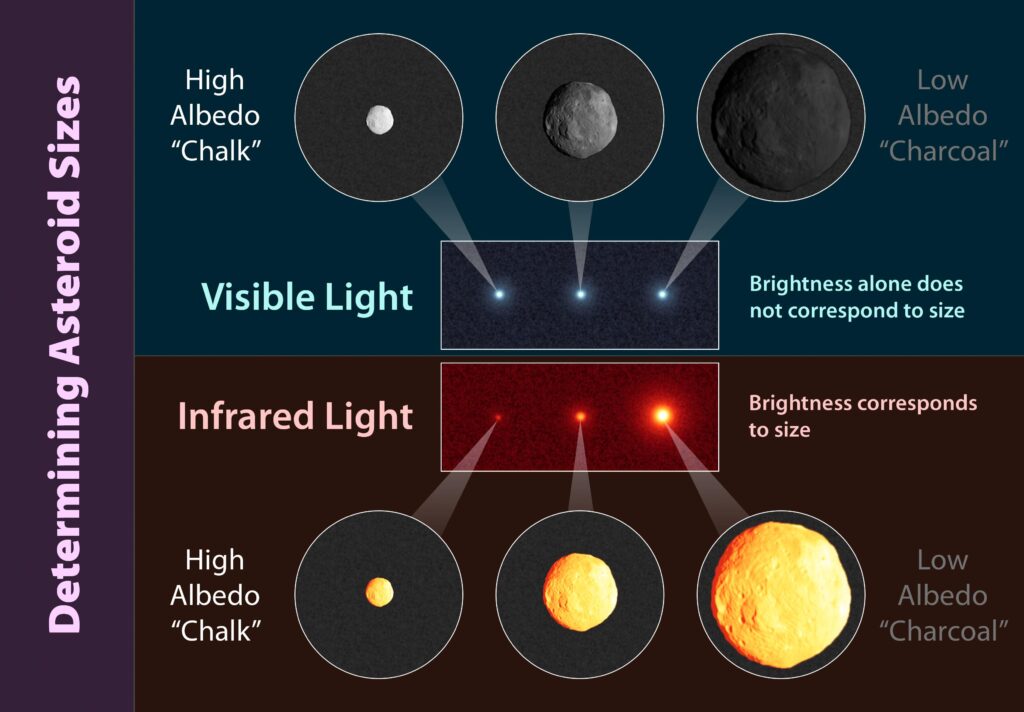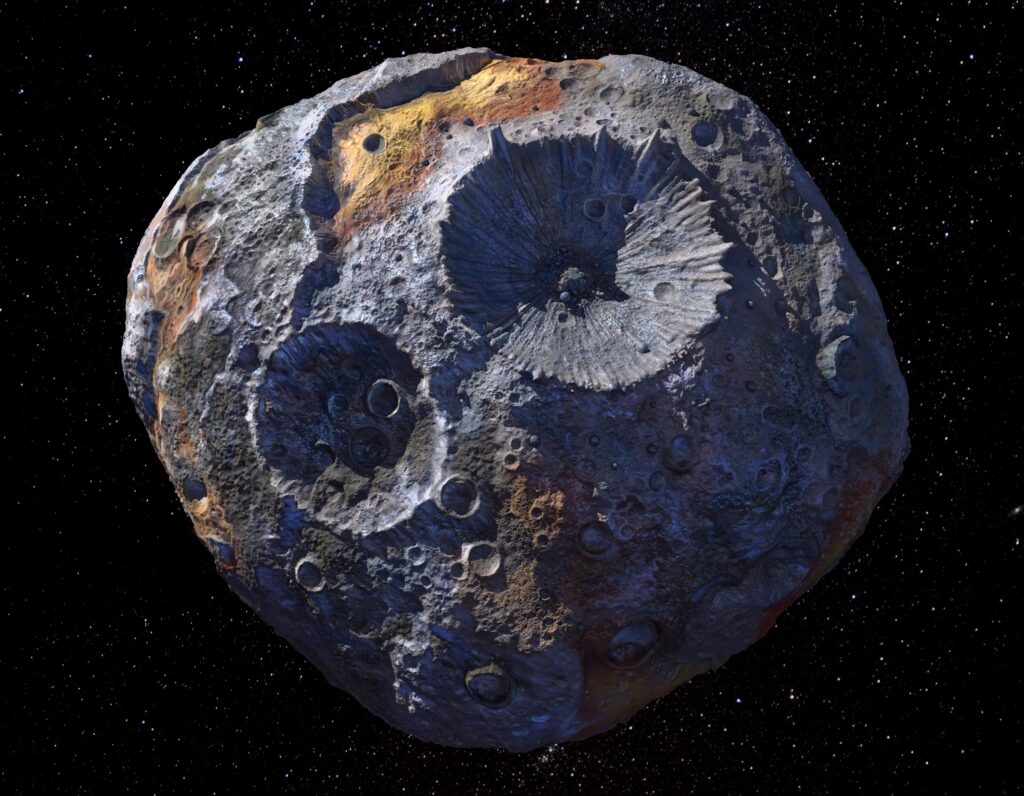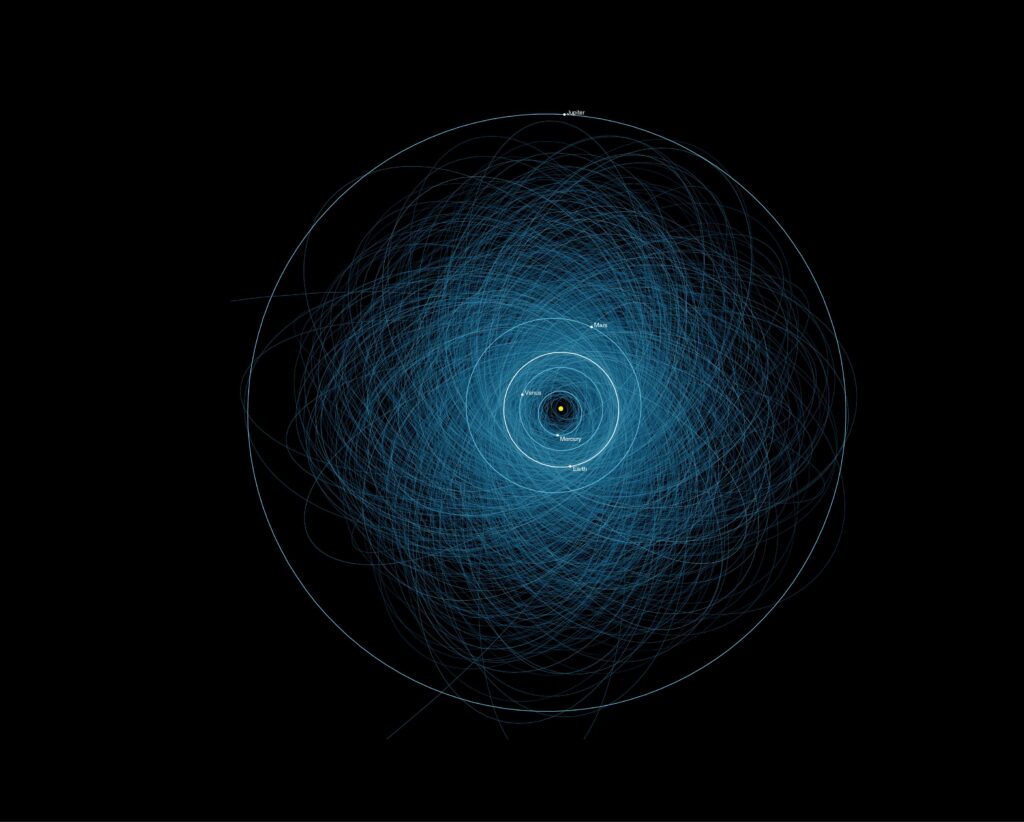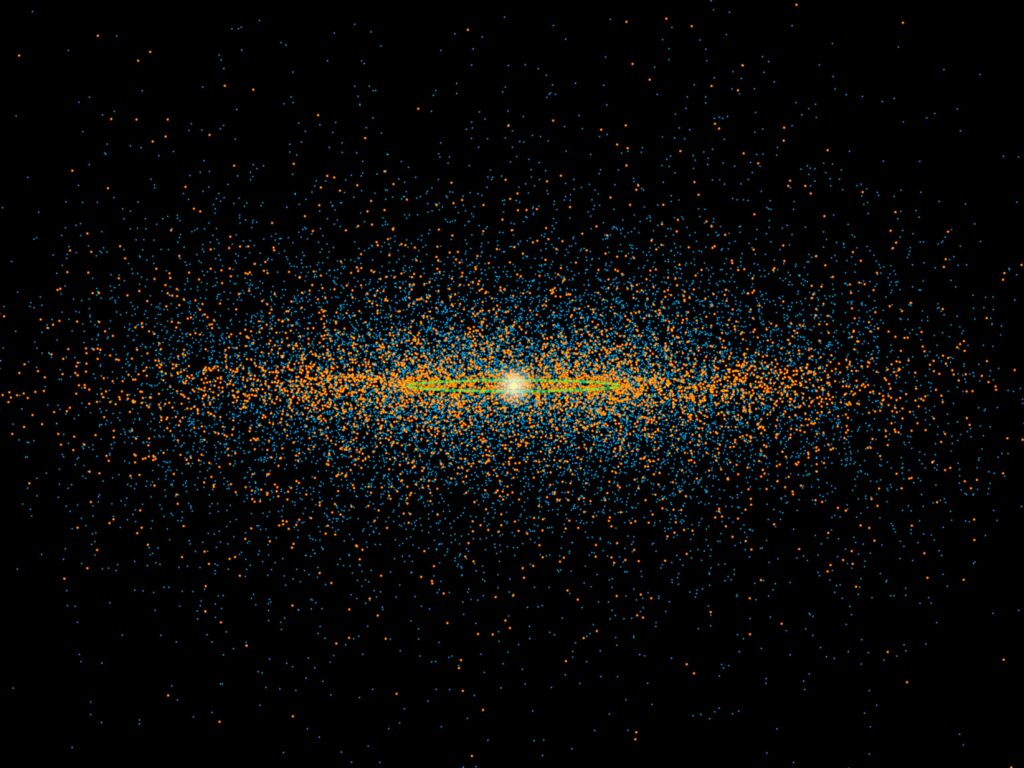Celestial Nomads of the Solar System
© ESA/Science Office
Asteroids, commonly known as minor planets or planetesimals, are objects orbiting within the inner Solar System that do not qualify as true planets or comets. These remnants from the early phases of the solar system’s formation provide distinctive perspectives into the cosmic narrative. These celestial bodies come in the form of rocky, metallic, or icy entities and lack an atmosphere. The sizes and shapes of asteroids exhibit considerable diversity, spanning from meter-sized rocks to dwarf planets with diameters nearly reaching 1000 km. Studying these asteroids contributes significantly to our understanding of the solar system’s early history and the myriad forms it assumed during its evolutionary journey.
The history involves the discovery of Ceres in 1801 by Giuseppe Piazzi, followed by the identification of Pallas and Juno in 1802. These early observations prompted the recognition of a concentration of small bodies between Mars and Jupiter, leading to the concept of the asteroid belt. Over the years, advancements in astronomy and space exploration have provided valuable insights into the orbital dynamics, physical characteristics, and potential impact hazards associated with asteroid.
Near-Earth asteroids pose a potential threat to all life on our planet, as exemplified by an asteroid impact event that led to the Cretaceous–Paleogene extinction. To address this concern, various asteroid deflection strategies have been suggested. Notably, the Double Asteroid Redirection Test spacecraft, known as DART, was launched in 2021. In a groundbreaking mission, DART intentionally collided with Dimorphos in September 2022, successfully modifying its orbit through the impact. This mission serves as a significant step forward in our efforts to develop and test techniques aimed at mitigating the impact risk posed by near-Earth asteroids, underscoring the importance of proactive measures to safeguard our planet from potential celestial hazards.
CHARACTERISTICS AND DIVERSITY

Asteroids are diverse in terms of their characteristics, including size, composition, shape, and orbital parameters.
SIZE
Asteroids vary widely in size, ranging from small rocky bodies a few meters in diameter to larger objects that can span hundreds of kilometers. The size spectrum is immense, with the largest asteroid, Ceres, holding the distinction of being a dwarf planet due to its substantial diameter of about 590 miles (940 kilometers).
These celestial objects come in various shapes, from irregularly shaped rocks to more spherical bodies. The diverse sizes of asteroids contribute to their dynamic interactions within the solar system, influencing factors such as gravitational perturbations, collisions, and orbital dynamics. Studying the size distribution provides valuable insights into the processes that shaped the early solar system and the role these objects play in the ongoing evolution of our cosmic neighbourhood.
COMPOSITION
Asteroids are composed of various materials, and their composition can be classified into different types based on spectroscopic observations. The three main types of asteroids are C-type (Carbonaceous), S-type (Silicate), and M-type (Metallic), each representing different combinations of minerals and elements. Here’s a brief overview of the composition of each asteroid type:
CARBONACEOUS
These asteroids are the most common and are found predominantly in the outer regions of the asteroid belt. They contain a significant amount of carbon, along with other elements such as water, clay, and organic compounds. C-type are generally dark in colour and are thought to be primitive remnants from the early solar system.
SILICATE
Silicate asteroids are composed mainly of silicate rock and nickel-iron. They are often found in the inner asteroid belt. S-type have a brighter appearance compared to C-type and are thought to represent a more differentiated and processed type of material.
METALLIC
Metallic asteroids are composed primarily of nickel and iron. They are typically found in the middle region of the asteroid belt. M-type are often dense and have a metallic luster. These asteroids are believed to be remnants from the cores of differentiated parent bodies that underwent significant heating and melting.
OTHER TYPES
In addition to the main C, S, and M types, there are other less common types of asteroids, including V-type (composed of basaltic rock), X-type (thought to be a transitional type between S and M), and others.
The classification of asteroid types is based on spectroscopic observations, which analyze the way asteroids reflect sunlight at different wavelengths.
SHAPE
Asteroids exhibit a diverse range of shapes, reflecting their dynamic histories and interactions within the solar system. The morphology of asteroids can be broadly categorized into irregular and more structured shapes. Irregularly shaped ones often resemble rocky fragments, with jagged edges and uneven surfaces. These shapes are a result of collisions and disruptive forces that have altered the original form of the asteroids. Some irregularly shaped ones may exhibit pronounced craters, grooves, and ridges, providing clues about their geological history.
On the other hand, certain asteroids display more structured or even spherical shapes. Spherical asteroids are often larger and may have undergone processes such as compaction or differentiation, leading to a more uniform and rounded appearance. The YORP effect (Yarkovsky–O’Keefe–Radzievskii–Paddack) is a phenomenon that influences the rotation and shape of asteroids over time, contributing to changes in their morphology.
SURFACE FEATURES

Asteroids exhibit a variety of surface features that provide valuable insights into their geological history, formation processes, and the effects of external forces.
- Craters: Like the Moon and other rocky bodies in the solar system, asteroids bear impact craters. These craters result from collisions with other objects, and their size and distribution can offer clues about the frequency and intensity of impacts over time.
- Regolith: Many asteroids have a layer of loose, fine-grained material called regolith covering their surfaces. This regolith is a result of the continual bombardment by micrometeoroids and the breakdown of rocks on the asteroid’s surface.
- Grooves and Ridges: Some asteroids display linear grooves and ridges on their surfaces. These features may be the result of internal processes, such as stress fractures or the cooling and contraction of the asteroid’s interior.
- Boulders: Large boulders can be scattered across the surface of asteroids. These may have been created by impacts or other geological processes, and their distribution can reveal information about the asteroid’s composition and structure.
- Pitted Terrain: Certain asteroids exhibit regions with pitted or crater-like formations. These pits may be the result of volatile substances vaporizing upon exposure to sunlight, a phenomenon known as sublimation.
- Bright and Dark Areas: Variations in surface brightness can indicate differences in composition. Dark areas may be rich in carbon or organic materials, while brighter regions may contain silicate minerals.
- Scarps and Faults: Some asteroids feature linear cliffs or faults known as scarps. These can result from internal stresses and movements within the asteroid, providing insights into its geological activity.
- Surface Color Variations: Spectroscopic observations reveal variations in surface colour that correspond to different mineral compositions. These color variations aid in classifying asteroids into different types based on their composition.
ORBITAL DYNAMICS

Orbital dynamics of asteroids involves the study of the motion and behaviour of asteroids as they orbit the Sun. They are small, rocky objects that primarily reside in the asteroid belt, which is a region between the orbits of Mars and Jupiter. However, some have orbits that bring them closer to Earth or other planets.
ORBITAL PARAMETERS
The orbital parameters of asteroids describe the characteristics of their orbits around the Sun. Key parameters include the semi-major axis, eccentricity, inclination, and orbital period.
SEMI-MAJOR AXIS (a)
The semi-major axis represents the average distance from the asteroid to the Sun. It determines the size of the asteroid’s orbit. The unit of measurement is typically in astronomical units (AU), where 1 AU is the average distance from the Earth to the Sun.
ECCENTRICITY (e)
Eccentricity measures the shape of the asteroid’s orbit. An eccentricity of 0 indicates a circular orbit, while values closer to 1 signify more elongated, elliptical orbits. Eccentric orbits are stretched, with the Sun not at the center but at one of the two foci.
INCLINATION (i)
The inclination is the tilt of the asteroid’s orbit relative to the plane of the solar system. It is measured in degrees. An inclination of 0 degrees indicates an orbit in the same plane as the solar system, while higher values indicate orbits that are tilted.
ORBITAL PERIOD
The orbital period is the time it takes for an asteroid to complete one orbit around the Sun. It is measured in years or days. Short-period asteroids have orbits less than 20 years, while long-period asteroids take more than 20 years to complete one orbit.
LONGITUDE OF ASCENDING NODE
The longitude of the ascending node defines the position where the asteroid’s orbit intersects the plane of the solar system. It is measured in degrees along the ecliptic.
ARGUMENT OF PERIHELION (ω)
The argument of perihelion specifies the angle between the ascending node and the point where the asteroid is closest to the Sun (perihelion). It is measured in degrees.
MEAN ANOMALY (M)
Mean anomaly is an angular parameter that represents the position of the asteroid along its orbit at a specific time. It is measured in degrees and helps determine the asteroid’s position in its orbit.
TYPES OF ORBITS
Asteroids can have various types of orbits, depending on their positions within the solar system.
MAIN BELT ORBITS
The majority of asteroids are found in the asteroid belt, a region located between the orbits of Mars and Jupiter. Asteroids in the main belt typically have orbits with semi-major axes ranging from 2.1 to 3.3 astronomical units (AU) and inclinations that vary.
NEAR-EARTH ORBITS (NEOs)
Near-Earth asteroids have orbits that bring them close to Earth‘s orbit. They can have a wide range of orbital parameters but are characterized by perihelion distances that bring them within 1.3 AU of the Sun. Some NEOs pose potential impact hazards, and they are closely monitored by astronomers.
TROJAN ORBITS
Trojan asteroids share an orbit with a larger celestial body, typically a planet, and reside at stable Lagrange points 60 degrees ahead of or behind the planet along its orbit. Jupiter Trojans, for example, share Jupiter’s orbit.
RESONANT ORBITS
Some asteroids are in resonant orbits with larger planets, which means their orbital periods are related to the orbital period of the planet. The most common resonance is the 3:1 resonance with Jupiter, where the asteroid completes three orbits for every one orbit of Jupiter.
TRANS-NEPTUNIAN ORBITS
Trans-Neptunian asteroids are located beyond the orbit of Neptune, in the outer regions of the solar system. They can have highly elliptical and inclined orbits.
HILDA FAMILY ORBITS
Hilda family asteroids are in 3:2 resonance with Jupiter, meaning they complete two orbits for every three orbits of Jupiter. They are found in a region between the 3:2 resonance and the 2:1 resonance with Jupiter.
CENTAUR ORBITS
Centaurs are icy bodies that have orbits between the outer planets, such as Jupiter and Neptune. They may display characteristics of both asteroids and comets.
JOVIAN AND RESONANT ORBITS
Jovian orbits and resonant orbits are two significant categories describing the paths of asteroids within the solar system. Jovian orbits refer to asteroids that are influenced by the gravitational forces of Jupiter, the largest planet. They are often found in the outer solar system, can experience perturbations and interactions with Jupiter, leading to distinct orbital characteristics.
Resonant orbits involve asteroids whose orbital periods are in specific resonant ratios with those of larger planets. The most common resonance is the 3:1 resonance with Jupiter, meaning the asteroid completes three orbits for every one orbit of Jupiter. Resonant orbits are stable configurations resulting from gravitational interactions, and they provide insights into the dynamical history of asteroids.
GRAVITATIONAL PERTURBATIONS
Gravitational perturbations play a crucial role in shaping the orbits of asteroids within the solar system. These perturbations are primarily caused by the gravitational influence of massive celestial bodies, with Jupiter being a significant contributor due to its substantial mass. As asteroids orbit the Sun, the gravitational pull from planets can induce changes in their orbital parameters, such as eccentricity, inclination, and semi-major axis. This phenomenon, known as a gravitational perturbation, can lead to resonances and interactions that significantly impact the long-term stability and behaviour of asteroids. The Yarkovsky effect, a consequence of uneven heating and cooling, is also associated with gravitational perturbations and can cause gradual changes in an asteroid’s orbit over time.
YARKOVSKY EFFECT
The Yarkovsky effect is a subtle yet significant force that influences the motion of asteroids in the solar system. It arises from the uneven absorption and re-emission of solar radiation by an asteroid’s surface. As the asteroid rotates and its surface alternately absorbs and emits sunlight, a small but persistent force is generated, imparting a subtle thrust that can alter the asteroid’s trajectory over time. This effect becomes particularly pronounced for smaller bodies with low gravitational influences. The Yarkovsky effect plays a crucial role in asteroid dynamics, affecting their orbital evolution, and spin rates, and potentially contributing to the delivery of asteroids into Earth-crossing orbits.
ROTATION AND SPIN
Asteroids exhibit various rotation and spin characteristics that are key to understanding their physical properties and evolutionary history. Rotation refers to an asteroid’s turning about its own axis, while spin refers to the combination of rotation and axial orientation. The rotation periods of asteroids can vary widely, ranging from a few minutes to several days. The YORP effect (Yarkovsky–O’Keefe–Radzievskii–Paddack) can influence the rotation and spin rates over time. This effect results from uneven absorption and re-emission of solar radiation, leading to changes in the asteroid’s rotational motion. As asteroids rotate, their irregular shapes and surface features can impact temperature distribution and influence their overall dynamics.
NEAR-EARTH ASTEROIDS (NEAs)

Near-Earth Asteroids (NEAs) are a group of asteroids with orbits that bring them into proximity with Earth‘s orbit. They pose a potential impact risk and are, therefore, closely monitored by astronomers and space agencies. NEAs have the following characteristics:
- Orbital Proximity: NEAs have orbits that bring them close to Earth. Their perihelion distances are less than 1.3 astronomical units (AU), where 1 AU is the average distance between Earth and the Sun.
- Potential Impact Risk: While the vast majority of NEAs pose no immediate threat, their close orbits raise the possibility of future Earth impacts. Scientists use various observational methods to track and predict the trajectories of NEAs to assess potential risks.
- Classification: NEAs can be classified based on their composition, size, and orbital characteristics. They may include various types, such as Atira, Amor, and Apollo asteroids.
- Observational Efforts: Ground-based telescopes and space observatories, along with dedicated surveys, regularly monitor and discover new NEAs. Projects like the Near-Earth Object Observations (NEOO) program aim to identify and characterize these asteroids.
- Space Missions: Some space missions, such as NASA’s OSIRIS-REx and Japan’s Hayabusa2, target NEAs for close-up studies, sample collection, and return to Earth. These missions provide valuable data for understanding the composition and origins of NEAs.
- Mitigation Strategies: Scientists and space agencies actively study potential methods for mitigating the impact risk of NEAs. These strategies include deflection techniques and early warning systems.
- Astronomical Importance: Studying NEAs is not only crucial for planetary defense but also offers insights into the early solar system’s dynamics and the potential for resource utilization through asteroid mining.
